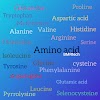RNA, abbreviation of ribonucleic
acid, complex compound of high molecular weight that
functions in cellular protein synthesis and replace DNA (deoxyribonucleic acid) as a carrier of genetic code in some viruses. RNA consists of ribose nucleotides (nitrogenous bases appended to a ribose sugar) attached
by phosphodiester bonds, forming strands of varying lengths. The nitrogenous
bases in RNA are adenine, guanine, cytosine, and uracil, which replaces thymine in DNA.
RNA typically is a single-stranded bio-polymer.
However, the presence of self-complementary sequences in the RNA strand leads
to intrachain base-pairing and folding of the ribonucleotide chain into complex
structural forms consisting of bulges and helices. The three-dimensional
structure of RNA is critical to its stability and function, allowing the ribose
sugar and the nitrogenous bases to be modified in numerous different ways by cellular enzymes that attach chemical groups to the chain.
Types of RNA-
Different types of RNA but three well known and most commonly studied are messenger RNA(mRNA), transfer RNA(tRNA), and ribosomal RNA(rRNA) which are present in all organisms.
1)Messenger RNA(mRNA)-
It carries information about a protein sequence to the ribosomes, the protein synthesis factories in the cell. It is coded so that every three nucleotides (a codon) corresponds to one amino acid. In eukaryotic cells, once precursor mRNA (pre-mRNA) has been transcribed from DNA, it is processed to mature mRNA.
This removes its introns—non-coding
sections of the pre-mRNA. The mRNA is then exported from the nucleus to the
cytoplasm, where it is bound to ribosomes and translated into its corresponding
protein form with the help of tRNA. In prokaryotic cells, which
do not have nucleus and cytoplasm compartments, mRNA can bind to ribosomes
while it is being transcribed from DNA. After a certain amount of time, the
message degrades into its component nucleotides with the assistance of ribonucleases.
It is a
small RNA chain of about 80 nucleotides that
transfers a specific amino acid to a growing polypeptides chain
at the ribosomal site of protein synthesis during translation. It has sites for
amino acid attachment and anticodon region
for codon recognition
that binds to a specific sequence on the messenger RNA chain through hydrogen
bonding.
3)Ribosomal RNA(rRNA)-
It is the catalytic component of the ribosomes. Eukaryotic ribosomes contain four different rRNA molecules: 18S, 5.8S, 28S and 5S rRNA. Three of the rRNA molecules are synthesized in the nucleolus, and one is synthesized elsewhere.
In the cytoplasm, ribosomal RNA and protein combine to form a nucleoprotein called a ribosome. The ribosome binds mRNA and carries out protein synthesis. Several ribosomes may be attached to a single mRNA at any time. Nearly all the RNA found in a typical eukaryotic cell is rRNA.
Subscribe for more information........!









0 Comments